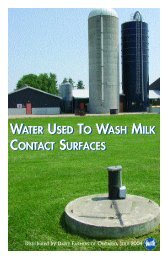Canadian Quality Milk On-Farm Food Safety Program - Centre ...
Canadian Quality Milk On-Farm Food Safety Program - Centre ...
Canadian Quality Milk On-Farm Food Safety Program - Centre ...
You also want an ePaper? Increase the reach of your titles
YUMPU automatically turns print PDFs into web optimized ePapers that Google loves.
<strong>Canadian</strong> <strong>Quality</strong> <strong>Milk</strong><br />
11.4 Troubleshooting Mastitis and High Somatic Cell Counts (SCCs)<br />
Identify Animals with Mastitis<br />
• Individual SCCs<br />
• Clinical case records<br />
• Past culture results<br />
• California Mastitis Test results<br />
• Abnormal milk & udders<br />
Environmental Infection<br />
• Coliforms (e.g. E.Coli, Klebsiella sp.)<br />
• Strep Non-Ags (e.g. Strep. uberis,<br />
Strep. dysgalactiae)<br />
Prevent New Cases<br />
• <strong>Milk</strong> clean dry teats<br />
• Reduce teat end<br />
vacuum fluctuations<br />
• Treat all cattle at dry<br />
off<br />
• Use proper infusion<br />
techniques<br />
11—10<br />
Solutions<br />
• Consider a vaccination<br />
program<br />
June 2010<br />
Identify Cause of Mastitis<br />
• Clinical cases as they occur<br />
• Culture high SCC animals<br />
• Culture quarter/composite milk<br />
samples of all animals<br />
Reduce Teat End Exposure to<br />
Bacteria<br />
• Keep all bedding clean and dry<br />
• Calve cattle in clean dry box<br />
stalls<br />
• Maintain dry cows and springing<br />
heifers in a clean and dry<br />
environment (see chapter 1)<br />
Caution<br />
• Analyze individual SCC reports but<br />
be aware that most environmental<br />
mastitis cases last only a few days<br />
and can be missed between tests<br />
Prevent New Cases<br />
• Use proper infusion<br />
techniques<br />
• Clean and sanitize the<br />
teats and dry with a<br />
single service towel<br />
• Pre-dip and dip all teats<br />
with a licensed product<br />
after milking (see chapter<br />
5)<br />
Contagious Infection<br />
• Staph. aureus<br />
• Strep. agalactiae<br />
• Mycoplasma bovis<br />
Solutions<br />
• Wear nitrile or latex gloves<br />
• Segregate infected animals<br />
• Reduce teat end vacuum<br />
fluctuation<br />
NOTE: For more information on management practices for preventing and controlling mastitis see Chapters 1, 3, 5<br />
Remove Source of<br />
Infection<br />
• Treat all cattle at dry off<br />
• Cull cattle with<br />
incurable infections<br />
• Screen all purchased<br />
cattle for mastitis (see<br />
chapter 3)<br />
• Work with your vet on<br />
selecting animals to<br />
treat during lactation
















